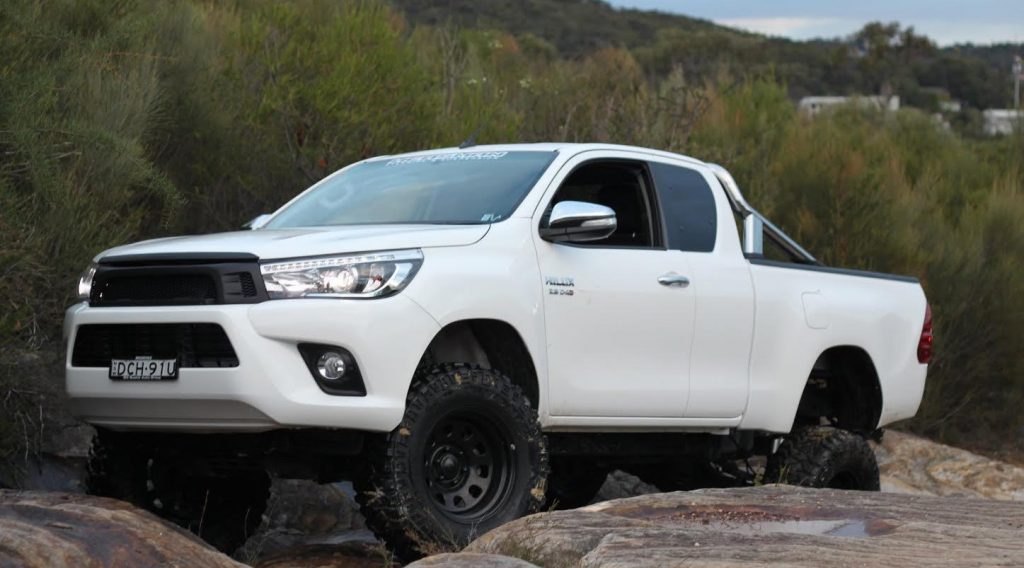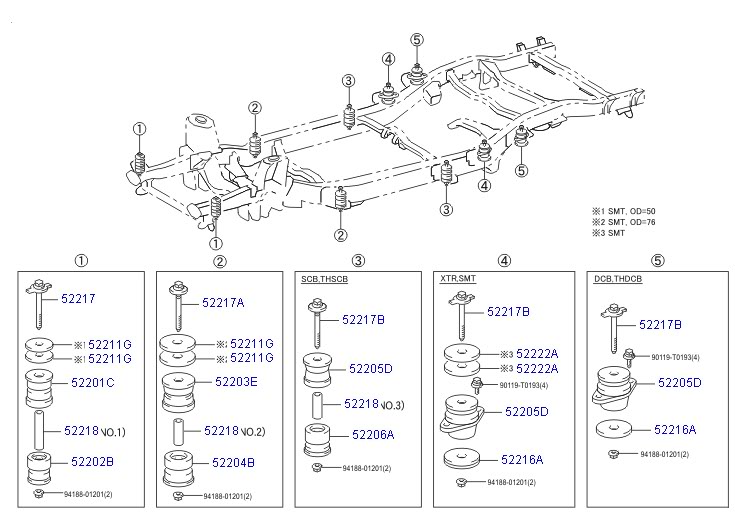DIY Bodylifting the Hilux 2005 and on

As we all know, a body lift is when we lift the body of the Hilux up and away from the chassis of the Hilux. On the older model, this hasn't been a problem due to the fact that most older Hilux's haven't had airbags fitted, but the current vehicle has and unfortunately for us up to now vehicle engineers have been hesitant to sign off on this particular modification because:
(A ) they don't understand how the airbag system work and (B) they are reluctant to sign off on a modification that (as I have been told by 2 different engineers in the past) may contribute to the death of a vehicle occupant in an accident by affecting the deployment of the airbags, and they are not prepared to stand in front of a judge and explain why they signed off on a dangerous modification. What a load of rot! They just did not want to do the work that VMN has done in attaining the necessary approvals.
The truth is, the modification is not dangerous if done properly and has been done for a while now is both Europe and South Africa.....some places in Europe are even engineering 4" body lifts (100mm) without suspension lifts, and being TUV Certified. For the last 7 years, body lifts have been readily available through VMN who have defined the market for body lift kits.
The VMN body lift kit solves all of these problems as it has type approval from the Queensland Department of Transport Main Roads which allows it to be legally fitted and engineered on vehicles in Queensland.
I'll begin with the location of the body mounts on the Hilux and then continue with the information you will all need to put forward to your vehicle engineer of choice to consider for a body lift for a Hilux if you decide to do it yourself rather than purchasing a VMN body lift kit

NOTE:
The front two factory body mounts as seen in the diagram above are 50mm OD and the rest are 76mm OD, meaning you must use the same diameter replacement blocks as a factory or larger otherwise the weight of the cabin is supported by mount smaller than the factory.
This could result in the floor pan cracking or worse, the mount joining you inside the cabin from the constant pounding on dirt roads. From experience, despite the Toyota technical information shown above, in the real world, you have to make the mounts larger than this and to be safe always use a VMN body lift kit which has proven the test of time over 7 years without a single failure.
"Hilux SRS Airbag system (April 2005 on)
The vehicle is equipped with a Supplemental Restraint System (SRS), which consists of a steering pad, front passenger airbag, seat belt pre-tensioner, centre airbag sensor and front airbag sensor. The location of these items is shown in Figure 1 and Figure 2, Below:


The schematic for the SRS components shown above are outlined in Figure 3 below:

Operation in case of front collision When an impact that is larger than a predetermined level occurs in the highlighted area in Figure 4. the airbag is deployed automatically.

The centre airbag sensor deceleration sensor uses the front airbag sensor's deceleration sensor signal to determine whether or not to activate the airbag. The centre airbag sensor safing sensor is designed to activate at a deceleration rate that is lower than that of the centre airbag sensor deceleration sensor.
When the safing sensor and deceleration sensor turns on simultaneously, current flows to the squib and the airbag deploys. This is shown graphically in the diagram below.

When the vehicle is in a collision and the shock is greater than the specified value, the SRS has activated automatically. The safing sensor and deceleration sensor are built into the centre airbag sensor. The safing sensor is designed to be turned on at a smaller deceleration rate than the deceleration sensor.
The deceleration sensor determines whether or not SRS deployment is necessary based on signals from the front airbag sensor. Current flows to the squibs to deploy the SRS when the conditions shown in the illustration in Figure 6 below are met.

Affect of a body lift on the SRS General Discussion
It can be seen from the technical description above that all of the SRS components and the wiring shown schematically in figure 3 are located on the passenger body shell. There are no SRS components or wiring attached to the vehicle chassis.
Therefore, there is no effect on the SRS system if the body shell is raised in relation to the chassis. The only possible consideration could be that the point of impact of a collision is higher where a body lift of up to 50mm is considered. However, it is noted that raising the point of impact by the same amount can just as easily be achieved by a 50mm suspension lift that fully complies with the suspension travel requirements of VSR 8. The point of impact in a frontal collision can also be affected if the vehicle is airborne at the time of impact.
This is quite probable where a vehicle leaves a built-up roadway and collides with a stationary object within the shaded areas of Figure 4. Under these conditions, if deployment conditions are met, the SRS airbags will deploy regardless of whether a body lift is installed in the vehicle or not.
Steering
The steering wheel and column contains two SRS components. The spiral cable and the steering pad containing the driver’s side airbag. These components are not affected where a body lift is installed as the spiral cable is designed to accommodate extension and compression of the steering shaft and the adjustable height steering column. Whilst a slight alteration in steering column angle may occur because of the body lift, this is within the limits of the adjustable height steering column. Airbag deployment is not affected by extending the steering shaft and the relationship between the steering pad and the driver remains within normal ergonomic limits that are expected for drivers of different physical characteristics.
For body lifts of 50mm, the steering shaft must be extended. Failure to do this could result in the steering shaft breaking. This is a serious concern and VMN is aware of several instances where this occurs. This occurs because there are insufficient spline engagement and the d of the shaft flexes fatigues and eventually snaps clean off. It is recommended that the steering shaft be extended by using the VMN steering extension which is included in all of our body lift kits.
Do not be tempted to use a steering extension like this which are designed for the earlier model and do not extend the steering sufficiently when body lifting the 2015 and on Toyota Hilux

The other essential component is a set of 4 radiator drop brackets. These need to be fabricated from 8mm or 10mm thick steel (8x32mm flat bar s a good choice). You need to drill 2 8mm holes in this piece 50mm apart. One of them should be countersunk and the other needs to be tapped to accept an 8mm thread.
There is a surprising amount of work in making these brackets and ensuring that all four of the brackets are the same dimensions and then coat them with undercoat and a top coat to prevent rust. We know because we used to make them this way. Today, the VMN radiator drop brackets are laser cut, countersunk and tapped on sophisticated production machinery so you can be assured of the accuracy of the parts. For the 2015 and on, they also need an additional hole drilled in them to ensure the top radiator mounts fit without modification. These parts are included in all of our kits. The 2016 and on need some additional components to allow the ductwork to the front mount intercooler. This involves machining up some spacers on a lathe.
If you have a style side ute body, the other parts you need to fabricate are tub override lift blocks. They sit in the rear wheel arches and support the rubber override blocks that help support the tub. Some people don't bother with these and run the risk of bending their tub if it is subjected to heavy, uneven loads. We include these in all of our Hilux style side body lift kits.
Once again, while these are simple enough to make if you can weld. You need to get a piece of 50mm SHS and some 3mmx50mm flat bar and makeup something like shown below. Buy the time it is welded up and painted with two coats, there is quite a bit of time involved in making these parts. It also can be hard to find the material you need as the SHS comes in 8m lengths and you only need around 25mm of it. The flat bar also comes in similar lengths.
If you have a diesel engine, you also need to ensure that the air inlet is extended, the vacuum line to the brakes is dealt with and do something with the intercooler if you have a top mount intercooler (eg Toyota Hilux 2005-2015), you need to ensure airflow to the intercooler is maintained. There are a number of ways to do this and we spent years trying to come up with a simple solution for this and we came up with an engine cover spacer.

This part simply fits beneath the plastic engine cover with the angled edge facing forward. Laser-cut and precision folded, the Hilux Bodylift Intercooler spacer is available at VMN at additional cost.
So then you also need to source the bolts required to fit the body lift blocks. On the face of it, this seems pretty easy really. Just measure the factory bolt length and buy some bolts which are 40mm longer. In fact, you may read something like this on the internet somewhere: "The bolts are M12x1.25 and the factory bolt length is 145mm so add your desired block length to that".
Well, that's all well and good except that you can't buy 195mm bolts in Australia and commercial bolts have much shorter lengths than the factory bolts. As a compromise, we provide a couple of different bolt lengths for the cabin body blocks. We have never been able to simply walk into a bolt shop and purchase the correct bolts.
They always have to be ordered in which takes a few days so you run the risk of your car being off the road waiting for something. This has recently been compounded because we finally purchased all of the 85mm long M12 x 1.25 bolts in Australia and have been forced to substitute a different bolt length for our style side body mount blocks.
So now you know what is involved in making up your own body lift for the 2005 and on Toyota Hilux, you can make an informed decision on whether you want to try putting it together yourself or simply buy the tried and proven VMN Body LIft kit and have the confidence that at the end of the day, your Body Lifted Toyota Hilux is out on the road and not still sitting on chocks waiting for more parts to arrive.










